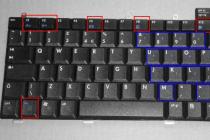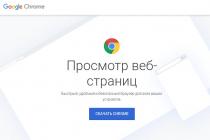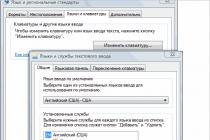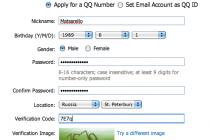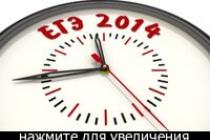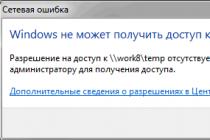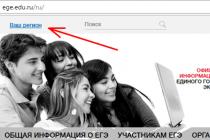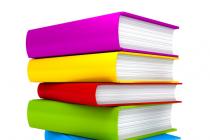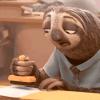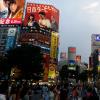2. Drawing tools, materials and accessories. Workplace organization
2.1. Drawing Tools. What will you need to complete the drawings at school?
cooking. A preparation is a set of drawing tools packed in a case. Usually, the preparation includes circular (Fig. 11, a) and marking (Fig. 11, b) compasses, a drawing pen for working with ink, an extension to a circular compass and other tools.
compasses. The graphite rod should protrude from the tip by 5...7 mm. The ends of the needle and the writing rod when working with compasses, as well as the ends of the needles of the marking compass, are placed at the same level (Fig. 11).
Rice. 11. Drawing compass: a - circular; 6 marking
Reisshina. During operation, the cross bar of the T-square is pressed against the left edge of the drawing board (Fig. 12). With the help of a T-square, horizontal and inclined lines are drawn.

Rice. 12. Drawing board and T-square
Drawing squares(Fig. 13). Together with a ruler or T-square, drawing squares are used to draw perpendicular and parallel lines and build some angles.

Rice. 13. Drawing squares: a - with angles of 90, 45, 45 °; b - with angles 90, 30, 60°
2.2. Drawing materials and accessories. Drawing materials and supplies include paper, pencils, rubber bands, buttons.
Drawing paper. For drawing use thick white unlined paper.
The pencils. To perform graphic work, you need T (hard), M (soft) and TM or HB, ST (medium hard) pencils. The larger the number next to the letter, the harder or softer the pencil.
A pencil properly prepared for work is shown in Figure 14. It is first sharpened with a sharp penknife or in a special sharpener. After that, the rod is sharpened with the help of a sandpaper - hard on a cone, and soft in the form of a spatula.

Rice. 14. Properly sharpened pencils
All drawing tools and materials must be kept clean and in good condition, the quality of the drawing depends on this.
2.3. How to work with drawing tools. Straight lines are first drawn along the edge of a ruler or square without pressure with a hard, sharpened pencil, and then outlined with a medium-hard pencil. In this case, the pencil is slightly tilted in the direction of movement, as shown in Figure 15. Horizontal lines are drawn from left to right, vertical and inclined lines are drawn from bottom to top.

Rice. 15. Techniques for drawing lines: a - horizontal; b - vertical; in - oblique
To get clearer and smoother lines when tracing, the pencil can be drawn along these lines repeatedly and in the opposite direction. When drawing vertical and inclined lines, the square is moved along the edge of the T-square or ruler from left to right, and when drawing horizontal lines, from top to bottom.
To draw arcs of circles, the leg of the compass is placed in the center. The compass is rotated by the head with the thumb and forefinger in the clockwise direction (Fig. 16). A short leg with a pencil insert and a compass needle in the working position should be parallel to each other. During rotation, the compass can be slightly tilted forward.

Rice. 16. Drawing a circle with a compass
When laying off the segments with a marking compass, do not press hard on it so as not to leave punctures on the paper.
2.4. Workplace equipment. The quality of the drawing largely depends on the correct preparation of the workplace.
The light on the drawing should fall from the top left. In this case, the shadows from the tools and hands will not interfere with the work.
Performing the drawing, you should sit straight, not hunched over. The distance from the eyes to the drawing should be approximately 300 mm,
At the drawing board, leave only those tools that are needed for work at a given time. In this case, the preparation, squares, pencils and an elastic band should lie on the right, and the book on the left. The drawing board should have a slight slope. In this case, it is easier to work, since you do not need to bend over the drawing much.
In design bureaus, drawings are made using a drawing instrument, which replaces a measuring ruler, square and protractor (Fig. 17).
Rice. 17. Drawing machine with a device
The work of the designer on the drawing is very laborious. Therefore, devices have recently been used that, according to a given program, automatically perform all graphic constructions. Such automatic devices for making drawings are called plotters.
To build drawings, electronic computers (computers) are also used. The TV screen (display) is increasingly replacing the drawing board. The designer sets the necessary data, and the computer automatically searches for the most rational solution.
- How to prepare a drawing compass for work? How do they draw arcs of circles?
- Why do you need a reyshina? How to work with her?
- How to prepare a pencil for work? What are the hardness grades of pencils?
- How to properly prepare a workplace for drawing?
In the workbook, on the instructions of the teacher, using drawing tools, draw vertical, horizontal and oblique lines, as well as circles.
Instructions for work. Try to draw all lines of the same thickness. Beautifully arrange groups of lines on a sheet of notebook.
We present you a selection of free services for the designer. This is the first option, in the future we plan to expand by adding new sections and tools.
Fonts
- Google Fonts is everyone's favorite font library. Allows you to select and download different fonts for all occasions.
- 1001 Free Fonts is a font library. It has easy navigation - fonts are sorted both alphabetically and by type. There is a section of Russian fonts.
- Fontstruct is an online font constructor. A very simple tool that will allow you to create your own font. You can draw not only with standard squares, but also with other shapes - dots, rounded corners, etc. For a beginner, an ideal tool to try and see typography in action.
- Font Squirrel is one of the largest font libraries. In addition, you can upload a picture and get the names of the fonts used on it. There is a font store, and even a clothing store with logos.
- Type light is a full featured font editor. Allows you to create, edit and convert OpenType, TrueType and PostScript fonts. You need to download and install. The free version has limited functionality compared to the free version. But to create a simple font is enough.
- What Font is is an online service for selecting site fonts. We load the font file, specify the site url and see how the downloaded font will look on the site. Convenient service.
- 1001 Fonts - a library of fonts (more than 15000). Easy navigation - font can be selected by size, type, theme, design, etc. The menu allows you to customize the output, which makes it possible to see each font in different options: size, style, etc.
- Font Flame is an online service for selecting a pair of compatible fonts. It works very simply - on the main page there is a leaflet with two inscriptions made in different fonts. If you liked it - press "Love", no - "Hate". Then the selected ones can be viewed again. Clicking on the font name opens Google Fonts.
- Typecast - font selection for the prototype. You can see how the font will look on any device. It is necessary to designate different types of text - headings, quotation marks, etc. You can choose a font, size, style, set indents. You will see your future page in the fonts you have installed. A big plus is the choice of layout (one column or several, different arrangements of blocks).
- Wordmark - allows you to choose the font installed on the user's computer for text, logo or heading. When you enter text in a field, it shows it in different fonts. You can select the size, case, display in black and white, or vice versa. Liked options are published in tritter or on Facebook - at the user's choice. Can be sent by email.
Photo stocks
- Unsplash is a constantly updated stock photo. The collections are divided into themes. You can find anything from "African Americans" to "Nature". Each photo has its own rating, you can see the best or new ones.
- FoodiesFeed - food photos. Images are categorized. You can choose the best, exclusive, icons, mockups, etc.
- Free Refe Photos is a huge list of "Real life" images. Mainly landscape and nature photography. Inconvenient navigation, all the photos on the main page appear when scrolling.
- Little Visuals - high-quality photos of landscapes and buildings. You can download the archive of the best photos posted in a week. Photos are hashtaged but not categorized.
- Gratisography is a huge library of free photos. All photos are divided into six themes: people, grimaces, cities, objects, nature and animals. You can search by words.
- Death to the Stock Photo - stock photos. You can't just look and choose. They make a selection for a month and let you download it after entering your email. The archive weighs about 11 MB. The best photos and a download link are sent to the mail.
- Superfamous - a large collection of photos from an unusual angle. The collection is small but interesting.
- The Pattern Library - patterns and textures. The set is large enough, the patterns are unusual. They are replaced by scrolling, and gradually. You can see how the template will look on the whole screen or on its part.
- New Old Stock - vintage photos from the archives. There are few free photos, but new ones appear regularly.
- Pexels - a large number of photos for all occasions. Broken down by topic, very easy to search.
- Jay Mantri - big set of photos. There is no classification as such, you can look at the months.
Stock graphics
- Brusheezy - free brushes, patterns, textures and more for Photoshop. 12 categories, each with subcategories. The choice is huge.
- Iconfinder - icons, both paid and free. You can download it in ICO, PNG, ICNS, SVG formats.
- Brushez is a large collection of Photoshop brushes. In addition to them, there are also vector primitives, shapes, templates, styles. Each section is divided into subsections. For example, there are more than 20 categories for brushes.
- Vecteezy is a library of vector graphics, including images and illustrations. A large number of categories and a huge - graphics.
- Iconbird is a Russian-language icon search service. You can enter a theme and get a set of icons, or you can browse by category.
- Icons8 is a Russian-language service that offers more than 42,000 icons on various topics.
infographics
- Vizualize is an online service for creating About Me infographics. Essentially, creates a graphic summary.
- Canva is an easy tool to create any kind of design. Allows you to design a presentation, poster, post in social networks, books, letters, materials and much more. Everything is done on the basis of templates, the text changes. But there are a lot of templates to choose from.
- Easelly - creating infographics based on templates. The built-in online editor allows you to change the design, place additional elements, change the text.
- Infogram is an online service for creating infographics and interactive charts. Not all features are available, you will have to buy an account.
- Visage is a simple tool for creating any visual content (charts, infographics, images for a blog, etc.). Lots of templates, simple editor. Some features are paid.
- Gliffy is an online charting service. The editor operates on the principle of Microsoft Visio.
- Visme is an online tool for creating presentations and infographics. Over 1000 templates. The editor allows you to add text (headings, lists, quotation marks and plain), animated text and widgets. In a free account, you can download as a JPG file.
- Piktochart - create high-quality graphics - presentations, infographics or printed material. PNG, JPG of different sizes are uploaded.
- Drawio is a convenient online service for creating diagrams. You can save to dropbox and similar services, you can save to disk.
- Venngage is an easy way to create infographics, posters, reports, social media content, and more. In the free version, it only provides a link to the publication. You have to pay to download.
- Cacoo is an online service for drawing diagrams and sitemaps. Probably the best available. Lots of tools and templates. You can export to PNG, PDF, SVG, PPT, etc.
- Creately is an online diagramming service. Available for publication only. The download is paid.
- Lucidchart is an online diagramming and drawing service. It is possible to import a Microsoft Visio diagram. Exported to PDF, PNG and JPG. There is paid functionality.
Colors
- Color Hunt - selection of color combinations. You can choose up to four colors. There are ready made solutions to choose from.
- TinEye - analyzes the site and displays a list of resources that use the image from the site.
- ColorZilla - allows you to create colors and gradients. Displays css properties for them.
- Adobe Color CC - creating color schemes.
- Colicious - press the spacebar and generate a new color.
- Colorscheme - selection of color schemes. There is a version in English and Russian. Allows you to choose colors for the site. Has a fine-tuning, shows the color code. Ultimately allows you to view the page in the selected color scheme. The biggest plus is viewing the gamut in terms of color perception deviation. It also allows you to select different color models. Saves to Gimp palette, CSS, PNG, etc. Has a color converter to convert from one color model to another.
- Paletton is a tool for creating color combinations. Nothing different from Colorscheme.
- Pictaculous - Parses the palette of a PNG, JPG, or GIF image. Upload an image and get a set of all the colors that are present in it.
- Hex Color Tool is a color selection tool. The sliders adjust the color, you can select the brightness. The selected color is then saved. You can choose a palette.
- (Un)clrd is a browser plugin that removes all colors and leaves the site in black and white.
- BrandColors is the largest collection of official brand color codes. Choose the name of the brand and download the names of its colors, including the css file.
- Colortyper - selection of colors from an unusual angle. The screen shows multi-colored symbols that intersect. The result of the intersection is the new color. Looks interesting.
Inspiration
- Dribbble - The largest community of designers. Jobs, communities, communication - you can find anything here.
- Freebbble - templates and designs from Dribbble. Some you can download for free, some you can buy. You can find templates for CMS, constructors, icons, mockups, made up website templates and much more.
- Muzli - Daily design inspiration. A resource for designers with examples of the most unusual work.
- Awwwards - the best developments of designers. Organized as a community where you can vote site. The site of the day, month, year, etc. is selected. A large number of design, video, developments.
- Design You Trust is a community of designers sharing the latest trends, news, portfolios, designs and creative announcements.
- Really Good Emails is a huge collection of well designed emails. Choose a template and get its html, css and js code. You can change text, pictures, etc.
- Fubiz - publications from the field of design and creativity. You can find photos, designs, graphics, videos, and more. Everything is categorized.
- Designspiration is a collection of Pinterest style designs. A huge number of ideas and examples - typography, logos, letters and much more.
- Behance is a collection of portfolios from professionals. You can leave a job or resume.
- Mobile-patterns is a library of iOS and Android screenshots. Everything is divided into sections. You can find many ideas.
- One Page Love is a gallery of the best web page designs. You can buy templates and themes. There are also free ones.
- Uispace is a resource for designers. You can download psd, sketch, fonts, mockups, etc. for free.
Graphic editor
- DAZ 3D - 3D modeling. Register and download the desktop application.
- Gimp is a free version of Photoshop. Allows you to set up a modular grid, create guides, work with layers, add effects, etc. It is a good free replacement for Photoshop. It is extensible - additional plugins can be downloaded.
- Blender - 3D modeling, animation, rendering, sound, video. Allows you to create games. Fast growing editor, very popular.
- Aviary is an online photo editing service. Lots of features, including red-eye, resizing, and more.
- Pixlr is an online photo editor and graphics editor separately. The latter is similar to photoshop. Saves to disk.
- BeFunky is an online photo editing service. Effects, frames, graphics, retouching and more. There is a Russian-language interface.
- Inkscape is a complete open source vector graphics editor. Supports the capabilities of the SVG format - working with shapes, contours, text, vectorization of raster graphics, etc. In addition to processing vector images, it allows you to create a site template and cut it - a modular grid is present. Allows you to draw backgrounds, banners, vector logos, etc.
- IconEdit2 is a very simple program for drawing icons. Has filters. Allows you to export an image for Android and Apple. You can adjust the color depth, rotate and adjust the icon. Supports translucency, multiple images in one ICO file, and anti-aliasing in all drawing tools.
- Falco GIF Animator is a program for creating frame-by-frame animation and animated icons. On the resource you can download many different programs.
- Krita is a professional open source desktop editor. Available for different OS.
- Boxy-SVG is a vector graphics editor similar to Adobe Illustrator, Sketch and Inkscape.
- Photopos is a multifunctional program, with the functions of a photo editor, a graphics editor and a computer graphics application.
- 5Dfly is a free batch photo editing application. Able to create slide shows for PowerPoint. Separately, you can download the converter to PDF.
- PaintStar is a free image editor. The interface is very similar to Paint, but there are more options. Layers, for example.
- PhotoScape is a simple photo editor. It has the functions of adjusting brightness and color, white balance, backlight correction, frames, balloons, mosaic mode, adding text, drawing images, cropping, filters, red-eye removal, colorization, brush, clone mark, effect brush, etc.
Not everyone has the money to spend on using the most expensive graphic design software, especially when starting a new business or starting a new design career. Many will use Adobe's fantastic Creative Cloud suite of apps by default, but for those who want to build a solid foundation, there are plenty of free graphic design software that can do the job as well. And do it very well.
But to save you the hassle of searching for such tools, we've compiled this list and divided it into five sections to make it easier for you to navigate.
VECTOR DESIGN SOFTWARE
Platform: online, PC,mac,linux,Chrome OS
Gravit Designer, formerly known as Plain Old Gravit, is a full-featured vector design application suitable for all kinds of jobs, from screens and icons to presentations, illustrations, and animations.
With a simple and intuitive interface that is customizable as needed, this free graphic design software contains many tools for creating detailed and beautiful vector images, including non-destructive booleans, as well as many fills, blend modes, and a powerful text engine.
It exports as a PDF, SVG, or bitmap, and if you need to access your project while you're on the road, Gravit Cloud can help you get to your work wherever you are.
Platform: online,mac,windows,linux,Chromebook
Available as both a browser-based web application and a standalone desktop application, Vectr is a free editor for creating 2D vector graphics. With all the vector features you could hope for, plus plenty of options for using filters, shadows, and fonts, it's versatile enough for everyday design tasks. Particularly useful are its collaboration and sync options, which allow you to connect with anyone, anywhere, and create in tandem.
Platform: web browser
Whether you want to quickly export to SVG or edit an already existing SVG file, there are several online editors that will do the job just as well as Adobe Illustrator. SVG is an open format that allows you to reproduce your vector drawings programmatically, and one of the best projects is SVG-Edit.
The tool is fully built on HTML5, CSS3 and JavaScript, does not require any third party server processes. So not only can you use it to create and edit documents, but because it's open source, you can also download and modify the code, creating your own version if you like.
It has a standard yet basic set of tools for every vector editor, and although limited to the SVG format, it's surprisingly capable.
Platform: Windows / Linux (Maybe Mac if you're tech-savvy)
Like many free options available, Inkscape focuses on the SVG format as its main file format. This highly efficient editor has very good SVG integration, supporting many of the more advanced features that are not always available in other applications, such as alpha blending, cloned objects, and markers.
Full support for multiple color modes means it's a viable alternative to Illustrator for both print and web design, and while the interface is somewhat simpler than Illustrator's, it's still possible to achieve complex artwork. Of note is the ability to trace bitmaps, support for variable stroke widths, and natural import of Illustrator files.
There are source binaries for Windows, Linux, and Mac, as well as compiled versions currently available for Windows and Linux.
FREE IMAGE EDITORS
Platform: PC
If you're on a PC and need a decent set of image editing tools without the paid Photoshop or GIMP's huge toolbox, then Photo Pos Pro should blow your mind. Created with the goal of image enhancement and editing, it's perfect for typical photo editing tasks like fixing contrast, lighting, and saturation, but it also expands to more advanced technologies.
The editor boasts a very user-friendly interface, as well as a deep help system to help you get started, and if you want to expand its toolset to suit your needs, there are plenty of extensions and plugins available.
Developed with input from VFX professionals and concept artists, illustrators, matte and texture artists, Krita is a free and open source painting tool that has been in development since 1999. It comes with a full range of brushes to suit any job, and there are a range of plug-ins available, from advanced filters to drawing assistants for perspective work.
Notable features include brush stabilizers to smooth out any shaky lines, a circular mode for creating seamless textures and patterns, and a pop-up palette for quick color selection.
Platform: iOS, Android
Free graphic design software Pixlr claims to be "the most popular online photo editor in the world." It boasts over 600 effects, overlays, and borders, plus it lets you do all the basic things you'd expect from a photo editor, from cropping and resizing to red-eye removal and teeth whitening.
If you're used to using Photoshop, then you'll find Pixlr's user interface quite easy as they are very similar. This free app is available for both iOS and Android.
Platform: Windows
Paint.NET is the Windows alternative to the Paint editor that Microsoft ships with Windows versions. However, don't let that fact put you off as this is an amazingly capable, useful, and best of all, free graphic design software.
The focus is on ease of use, and there's also a definite trend towards photo editing rather than artistic creation. However, there are a number of special effects to easily create fake perspectives, blend pixels around the canvas, tile and reselect, etc.
A good set of selection tools, support for layers, and tweaks like curves and brightness/contrast mean Paint.NET is a great alternative to Photoshop for photo editing, especially if you can get by without some of the new additions to Photoshop's toolbox.
Platform: Web browser (requires Adobe Flash Player)
Sumo Paint is a high performance browser-based image editor. All the standard features you'd expect from a desktop tool are present and correct, and by purchasing the Pro version, you can install the desktop version of the app if you wish.
You will need Adobe Flash Player to use this tool, so you won't be able to use Sumo Paint on your iPad. However, it loads easily and quickly, and the free version is very convenient.
This includes the standard set of tools and settings that you would expect to see. Brushes, pencils, shapes, text, cloning, gradients, and more are all quickly accessible from the floating toolbar. The editor can also open saved documents from your hard drive, making Sumo Paint a great option for editing and republishing.
Platform: Linux, Windows, Mac
A free and open source graphic design software that debuted on Unix-based platforms, GIMP stands for nothing more than the GNU Image Manipulation Program. And today the editor is available in versions for Linux, Windows and Mac.
The GIMP interface is somewhat different from Photoshop, but a version is available that mimics the look and feel of Adobe, making the transition easier if you've left Photoshop behind. A complete set of tools is available - everything you're used to is within easy reach, including drawing tools, color correction, cloning, selection, and enhancement.
The development team has worked hard to ensure compatibility so that you can work with all popular file formats without any problems. You'll also find a very capable built-in file manager, just like Adobe Bridge.
3D SOFTWARE
Platform: PC, Mac
To get your first foothold in the world of 3D, the free version of Sketchup Make is the perfect solution. It provides a friendly and indulgent introduction to creating materials in 3D, starting with simply drawing lines and shapes that you can then advance and drag to turn them into 3D shapes.
If you need some inspiration, you can find it in SketchUp 3D Warehouse's huge library of models and download them for free.
Platform: Mac, Windows
Daz Studio is a 3D figure customization, posing and animation tool that allows artists of all skill levels to create digital art using virtual people, animals, props, vehicles, accessories and environments.
With Daz Studio, you can create your own 3D characters and avatars, create virtual environments, graphic design elements, and more. There's also a handy table that shows you what this free tool has to offer compared to its paid alternatives.
Platform: Mac, Windows, Linux
If you're serious about 3D but struggle to afford the software, then you're in luck. Blender is a free and open source 3D content creation suite available for all major operating systems.
Created by Blender Foundation founder Ton Roosendaal back in 2002, Blender has become the largest open source 3D content creation tool. Its creators are constantly working on its development, but you can easily do something today, including modeling, texturing, animation, rendering and compositing.
Platform: Mac, Windows
If you're interested in the art of digital sculpting, check out Pixologic's Sculptris 3D software. It's the perfect solution for all skill levels and is a great starting point for users unfamiliar with the discipline, while more experienced CG artists will find the software a quick and easy way to bring their concepts to life.
Sculptris is based on ZBrush Pixologic, the most widely used digital sculpting application on the market today. So, when you're ready to go to the next level of detail, the skills learned in Sculptris can be directly transferred to ZBrush.
Platform: Mac, Windows, Linux
Houdini is a 3D animation and visual effects tool widely used throughout the media industry for film, television, entertainment and visualization. And its cheapest version costs just under $2,000.
But the creators of the program, Side Effects Software, knowing that cost could be an issue, offered a free version of Apprentice. Thanks to this, you can access all the features of the full version to develop your skills and work on personal projects. The program is intended solely for non-commercial and educational purposes.
DATA VISUALIZATION SOFTWARE
Platform: web browser
Google Chart Tool is powerful, easy to use and free. You can choose from a variety of charts and customize a wide range of options to perfectly match the look and feel of your site. Plug in real-time data and Google Chart is the perfect infographic generator for your website.
Platform: web browser
It was only a matter of time before the resume infographic generator appeared. With it, you can visualize your resume in one click, as well as take a look at previous examples. To enable people to express their professional accomplishments in a simple yet compelling personal visualization, we think this is an option worth exploring.
Platform: web browser
This free web infographic tool offers you a dozen free templates to get you started right away, and all of them are highly customizable.
You get access to a library of things like arrows, shapes, and connectors, and you can customize text with a range of fonts, colors, styles, and text sizes. The tool also allows you to upload graphics and place them with a single tap.
Platform: web browser
Infogram is a great free tool that offers access to a wide range of graphs, charts and maps, as well as the ability to upload images and videos to create cool infographics.
The data on which the infographic is based can be found in an Excel spreadsheet that the user can easily edit and see how the results change in real time. When you're done, you can publish your infographic on the Infogram website for everyone to enjoy, or embed it on your own website, and share it on social media.
OTHER USEFUL TOOLS
Platform: Online, PC, Mac, Linux, ChromeOS
Klex is an easy-to-learn and affordable tool for anyone who wants to create impressive graphics with just a few clicks. While it's clearly not aimed at professional designers, it's the perfect tool for those who want to quickly create memorable designs. There are plenty of ready-made templates to choose from, thousands of assets, a wide range of effects and filters, as well as customization options, downloading fonts and text assets.
Platform: Windows
If you are a PC user, Microsoft has made their free Expression Web 4.0 application for you. There's no free tech support available, but it's a pretty powerful Dreamweaver alternative that won't cost you a dime.
Basic concepts of computer graphics
The image on the screen consists of small cells. Each of them can have a specific color. Such a cell is called a pixel. A set of pixels makes up a matrix and forms an image on the screen. Depending on the monitor model, the matrix parameters in pixels can vary: 640x480, 800x600, 1024x768, 1600x1200...
The size of the matrix does not affect the physical size of the screen and does not depend on it. The larger the matrix on the same screen, the smaller the cell size, and, therefore, the image quality is better.
It should be clearly distinguished:
Screen resolution
Printer resolution
Image resolution.
All these concepts refer to different objects. With each other, these types of resolution are not related in any way, until you need to know what physical size the picture on the monitor screen, print on paper or file on the hard drive will have.
Screen resolution is a property of the computer system (depends on the monitor and video card) and the operating system (depends on Windows settings). Screen resolution is measured in pixels and defines the size of an image that can fit on the entire screen.
Printer resolution is a property of a printer that expresses the number of distinct dots that can be printed in a unit length area. It is measured in units of dpi (dots per inch) and determines the size of an image at a given quality, or vice versa, the quality of an image at a given size.
Image resolution is a property of the image itself. It is also measured in dots per inch and is set when creating an image in a graphics editor or using a scanner. The resolution value of an image is stored in the image file and is inextricably linked to another property of the image, its physical size.
The physical size of an image can be measured both in pixels and in units of length (millimeters, centimeters, inches). It is set when the image is created and is stored with the file.
If the image is being prepared for display on the screen, then its width and height are set in pixels to know how much of the screen it occupies.
If the image is being prepared for printing, then its size is given in units of length in order to know what part of the sheet of paper it will occupy.
Image types.
Black and white line art
For each pixel of such an image, one bit of information is allocated. One bit encodes two states, in this case these are two colors: black and white.
Halftone images
A grayscale image pixel is encoded with 8 bits
Indexed Colors
The first color monitors worked with a limited color gamut: first 16, then 256 colors. They were encoded with 4 bits (16 colors) or 8 bits (256 colors)
Full color images
True color includes image types with a color depth of at least 24 bits, that is, each pixel of such an image is encoded with at least 24 bits, which makes it possible to display at least 16.7 million shades.
File formats
Format (format) is a bureaucratic concept to a certain extent, everyone had to fill out all kinds of questionnaires. The questionnaire is a format for organizing data, it is tedious to fill out, but then it is easy to process. Without a format, information does not exist.
For each type of computer activity, there are standard formats, that is, the most convenient, or frequently used. For texts, such formats are DOC, TXT, for printed products - TIFF, P1CT, for graphics on the Internet - GIF, JPEC, etc.
Computer graphics tools
A video card (other names: graphics card, video adapter) controls the operation of the monitor, freeing the processor from building image frames.
The quality of the video card determines the speed of processing video information, the clarity of the image, the number of colors on the screen and the resolution in which the monitor will work.
Monitor
In the 19th century, a painting technique arose in France, which was called pointillism: the drawing was made up of multi-colored dots applied with a brush to the canvas. A similar principle is used in computers. There are monitors based on different physical principles. On the screen electron beam monitor, the image is displayed on the “lines” that the electron beam draws as it runs across the screen.
Screen liquid crystal The monitor is a matrix, each element of which is a liquid crystal (as in an electronic watch). The crystals are illuminated by special lamps. Under the action of electrical signals, the crystals change their optical properties, simulating image elements on the screen.
Advantages
- good image quality;
- relatively low price.
disadvantages cathode ray monitor:
Harmful effects on human health.
Advantages
no harmful radiation;
Takes up little space
Consumes little electricity.
disadvantages liquid crystal monitor:
· high price;
Not very good color reproduction.
Mouse
The most common type of manipulators.
Graphics tablet
A digitizer is used to enter drawings or drawings into a computer. The image is converted to digital data. The conditions for creating an image are close to real, it is enough to make a drawing on a special surface with a special pen. The results of the work are reproduced on the monitor screen and, if necessary, can be printed on paper. Digitizers are commonly used by architects and designers.
The pen is the source of the signal that is received by the antenna inside the tablet. It is a wire mesh with a pitch of 3-6 mm or a similar printed circuit board. The antenna receives the signal and determines the position of the manipulator, as well as other data. The physical resolution limit of a tablet is determined by the grid spacing. The error of modern graphic tablets is no more than 0.1 mm.
Now tablets have become very popular due to the rapid development of the Internet and the popularization of electronic signatures for use in various operations. Design programs have reached a new level, where without graphic tablets it is very difficult.
3D graphics
Three-dimensional graphics (3D, 3 Dimensions, Russian 3 dimensions) - a section of computer graphics, a set of techniques and tools (both software and hardware) designed to depict three-dimensional objects. It is most commonly used to create images on a screen plane or printed sheet in architectural visualization, cinema, television, computer games, printed materials, as well as in science and industry.
A three-dimensional image on a plane differs from a two-dimensional one in that it involves the construction of a geometric projection of a three-dimensional scene model onto a plane (for example, a computer screen) using specialized programs. In this case, the model can either correspond to objects from the real world (cars, buildings, a hurricane, an asteroid), or be completely abstract (a projection of a four-dimensional fractal).
To obtain a three-dimensional image on a plane, the following steps are required: modeling - the creation of a three-dimensional mathematical model of the scene and objects in it. rendering (visualization) - building a projection in accordance with the selected physical model. output of the resulting image to the output device - display or printer.
However, due to attempts at 3D displays and 3D printers, 3D graphics do not necessarily involve projection onto a plane.
Conclusion
The need for widespread use of graphic software has become especially noticeable in connection with the development of the Internet and, first of all, thanks to the World Wide Web service, which linked millions of separate "home pages" into a single "web". Even a cursory tour of these pages is enough to understand that a page designed without computer graphics has no chance to stand out from the background of the widest range of competitors and attract mass attention. The vast majority of web pages, along with textual information, contain graphic images. The lion's share of the pictures loaded in the browser window are created in GIF or JPEG formats.
Vector graphics represents an image as a set of geometric primitives. Usually, points, straight lines, circles, rectangles are chosen as them, and also, as a general case, splines of a certain order. Objects are assigned some attributes, for example, line thickness, fill color. The drawing is stored as a set of coordinates, vectors and other numbers characterizing a set of primitives. When rendering overlapping objects, their order matters.
Raster graphics
An example of a raster drawing A raster graphic always operates with a two-dimensional array (matrix) of pixels. Each pixel is assigned a value - brightness, color, transparency - or a combination of these values. A bitmap image has a number of rows and columns.
fractal graphics
fractal- an object whose individual elements inherit the properties of parent structures. Since a more detailed description of elements of a smaller scale occurs according to a simple algorithm, such an object can be described with just a few mathematical equations. Fractals make it possible to describe entire classes of images, the detailed description of which requires relatively little memory. On the other hand, fractals are poorly applicable to images outside of these classes.
Buying everything that is required for creativity, it is easy to get carried away and get superfluous or completely unnecessary. Try to limit yourself to only the essentials at first, and then you can add new tools and materials as needed. Always choose the best as your budget allows, because cheap purchases are often disappointing - the wrong pigment shades, the wrong paper texture or the fibers from the brush are strewed.
Brush types
Brushes add color to surfaces large or small, but they can also create lively and very dynamic lines, both subtle and contrasting. Spring brushes are much more expressive than sluggish ones, so to maintain the quality of the brushes, be sure to rinse them after the end of the session, and brushes should only be stored in an upright position.
Brushes come in a variety of shapes and sizes. Round, pointed brushes with long hair apply broad or fine strokes. But round pointed brushes with short hair are easier to use, they are convenient to prescribe small details. Flat brushes with short or long hair are suitable for covering large surfaces.
The best material for creating brushes is kolinsky. Such a brush is expensive, but it is very strong and durable, and also gives excellent results.
Squirrel and synthetic brushes are cheaper, but still produce good quality drawings. Quality brushes last a long time, and over time you will accumulate a good collection.
To get started, buy nylon brushes, take a couple of wide brushes - they prescribe the details and fill well enough. You can also purchase an oriental alternative to expensive sable and squirrel brushes. A brown kolinsky brush, which springs well when wet, paints details, and a soft white goat brush perfectly covers wide surfaces of paper or canvas with a wash.
Simple pencils
Good old "lead" pencils in a wooden frame with a lead made of a mixture of graphite powder and clay have many advantages: they are economical, compact, versatile and convenient to take with you. On such pencils there are designations of different hardness: "H" - hard, and "B" - soft. Hard pencils are for technical drawings, and the line they draw is pale and inexpressive.
For artistic drawing, pencils marked “B” are better suited, where there is much more graphite than clay. The higher the number next to the letter, the softer the pencil lead will be and the faster it becomes dull, but the line turns out to be blacker and easily smeared. When buying, choose quality pencils or leads that clearly indicate their softness. For starters, "2B" will do.
If you draw with pencils of different hardness, try to make the black color prevail, and do not expand the range of halftones too much. A short sharpened pencil will dull quickly, so try to sharpen longer pencils using a sharp knife. Erase the pencil drawing only with a soft eraser. So that the lines made with a soft pencil are not smeared, they are fixed with a fixative.
When creating a drawing with many small details, try to sharpen the lead more often so that it always has a sharp tip. Leads on soft pencils get dull quickly and need to be sharpened constantly. Try to do this so that the wood frame is far enough away from the tip of the stylus, otherwise it may scratch the paper and damage the drawing itself.
Among the types of pencils, one can distinguish types with a wide lead, like a cutter, which draws a very wide line.
There are an incredible number of colored pencils, and it is very interesting to experiment with them. Try, for example, applying one color to paper, and then another on top of it, and you will get a new color. Or “mix” the shades like this: draw multi-colored dots or lines close to each other on paper as the famous French artist Georges Seurat did - you will get a very unusual and beautiful effect.
Individual graphite rods have the same graduation as wooden pencils. Actually, these are thick pencil leads, only without the usual wooden frame. They are widely used in painting, because they create a winning uneven texture, and they cover large surfaces very quickly.
Note that a line made with a dry, water-soluble graphite pencil spreads widely when blurred. Soft pencils dissolve the easiest. Before using a pencil, check its effect on a draft to determine the degree of moisture.
Crayons and wax pencils
For drawing fine and precise lines, these very soft materials are not at all suitable, but they excellently cover the surface on large, loose and textured drawings. Pastel is made in a wide range of colors, and each color always has several shades.
Many manufacturers number shades of the same color with numbers from 0 (lightest) to 8 (darkest). Pastel can be purchased either in pencil form or rod form. Pencils are harder and easier to sharpen. Both of them are sold in ready-made kits or in bulk. First you should buy a few pieces and try how comfortable it is for you to work with them, whether you like pastels at all. In addition, this way you will determine the colors that you use most often, and then you can gradually replenish your collection.
Pastel caret is a hard pastel, and artistic crayons are dry oblong rods, tightly pressed from a pigment erased into powder, to which a binder is added - gum and clay for hardness.
In cross section, pastel is usually square, it creates a beautiful, expressive line, but it is difficult to erase. As a rule, the color range of earthy shades is the most persistent. The tip of the pastel is blunt and wide, but it can be easily grinded off. By turning the crayon that has been sharpened on one side, you can get a thinner line. Pastel pencil leads are similar in composition to pastel and are perfectly combined with it if the drawing requires a more subtle study.
Soft pastels are pigments with a small amount of gum (gum arabic), chalk or dark paint for a lighter or darker color. It crumbles very easily, turning into dust, and erases well with a plastic eraser.
The pastel has to be fixed with a fixative, but the beauty of a velvety pastel is created precisely by the light reflected from the dust particles, so the excess of the fixative makes the drawing faded.
If you mix too many shades of soft pastels, the drawing will look messy, so moderation is very important here, and in the beginning, it is better to choose simple mixtures. Oil pastels, like wax crayons, have a dense coating, which allows them to scratch out a pattern on the surface applied by them.
If you are working on paper stretched on a stretcher, glued with gum arabic, or held in a hoop, then oil pastels and wax crayons can be thinned or completely removed with turpentine or mineral spirits. The drawing made with these materials also needs to be fixed.
Different types of handles
It's impossible to list all the handles because new types are added all the time. Here are just a few examples.
Fountain pens, familiar to artists, consist of a holder and a removable nib. They are dipped in ink or any other liquid dye. The best are traditionally steel flexible nibs with a split tip, in which different degrees of pressure allow you to draw a variety of expressive lines and strokes.
Unfortunately, color inks for drawing made from synthetic dyes fade extremely quickly. Therefore, choose a permanent water-soluble ink from traditional formulations.
Sometimes in specialized stores you can see reed and bamboo feathers. A thin reed pen (kalam), like a strong bamboo one, is not flexible, but their tips can be written at different angles, creating many different lines and strokes.
Ordinary technical pens are convenient to carry and easy to use. They are a mechanical device with a pointed tube, designed to create lines of a certain thickness. It takes a lot of skill and ingenuity to make their "boring" lines interesting.
Refillable pens can save you money, but choose ones that are easy to clean. Automatic pens draw ink into the internal cartridge, so it is very convenient to take them with you when you go sketching. Some pens are even equipped with interchangeable heads that allow you to draw different types of lines.
Ballpoint pens can also be a useful tool for sketching, just make sure that they do not put blots and draw a quality line without “slips”.
Coal
An ancient painting medium, charcoal, is made from olive or willow branches that are burned with minimal oxygen. Modern options include pressed charcoal and special charcoal pencils. All of them, although not completely, are erased with a soft eraser. True, a drawing made with charcoal, as in the case of pastel, requires fixing. Sauce is a thick lead used to create a thin or thick stroke, as well as a wash.
Usually, carbon rods are sold both in bulk and in packs. They come in different sizes, from thin to very thick (the so-called "stage"), and are divided into three categories according to hardness - hard, medium and soft. All of them create a quick and easy to remove cover of different shades, from dark gray to brownish and black.
Pressed charcoal is sold as a pastel. A high concentration of soot allows you to apply very dense, slightly oily strokes that have expressiveness and saturation, but it is useless to erase them. There are also gray charcoal rods in which soot is diluted with chalk.
Typically, charcoal pencils are either sold in large packs, like charcoal, or graded in hardness, like graphite. Their advantage is that with their rich tonality they emphasize the expressiveness of a pencil drawing. The comte pencil (especially the hard crayon invented by the French scientist Nicolas-Jacques Comte) is a bit more greasy than the charcoal and hardly rubs off. It is not as fragile as charcoal and comes in black, white, terracotta and sepia colors. Sanguina is a soft rimless pencil, red-brown in color. A graphite pencil is a favorite material of many artists. It comes in different softness and can be used both for instant sketching and for drawing small details.
If you're going to work wet, stretch a sheet of paper over an unvarnished board to prevent moisture from warping it. Cut four pieces of water-based gum arabic tape (they should be slightly longer than the edges of the sheet), and then gently dampen the paper with a sponge.
Run a sponge over the dampening tape and stick all four pieces - half on the board, the other on paper. Then the sheet will remain flat, and after drying it will be securely attached to the stretcher. It will be possible to remove it by carefully detaching the side tapes.
Water based paints
Most paints and inks are water-based and can be easily thinned to achieve desired color intensity. So, watercolors can be both bright and muted. They create a soft effect, especially when applied to soft and thick paper. Usually, liquid paints work on paper of heavy grades. In addition, you will need a palette on which you will mix colors, as well as a surface on which to place jars of ink, paint, water and some brushes.
Surprisingly, wax crayons and pastel pencils are perfectly combined with water-based paints: they do not mix with each other, which allows you to achieve special effects. The expressiveness of the picture increases when using liquid and dry paints.
Unlike water-based paints, oil paints dry very slowly, are expensive, and require good skill to use effectively. Water-based paints, like inks, are cheaper and more suitable for beginners.
If you apply ink with a pen, drawing lines, and then blur with a brush, the drawing will be more artistic and voluminous. These two methods can also be used separately. In order to keep a sharp line under the wash, draw it with waterproof ink. After the main drawing made with ink has dried, a color wash can be applied on top, which will not damage the lower drawing. The inks give vibrant color and are easy to blend. Some inks, especially water-resistant inks, can damage the brush, especially if it is not rinsed thoroughly, so it is best to have a special medium-quality brush for working with ink.
Familiar to everyone, watercolors are a finely ground pigment that easily penetrates the paper, giving it a lasting color. Really good paints are expensive, but they are stable and are bright and shiny.
For large jobs, immediately purchase tubes or concentrated dilution liquid. For small drawings, it is enough to buy a small box of hard paint tiles, although breeding them is a rather tedious task. If your budget allows, buy large ceramic cups with semi-soft paint. An interesting combination can be obtained from watercolors with water-soluble colored pencils, which, unlike graphite, do not show through the watercolor layer, but gently dissolve in it. They can even be washed before they dry before being covered with wet paint.
If you draw on wet paper, the pencils immediately lock in and come to life. Sometimes you can use oil pastels and wax crayons - watercolor rolls off grease stains, coloring only uncoated areas of the paper, resulting in a very unusual effect.
Gouache is a dense matte water-based paint. The best gouache is sold only in tubes, poster gouache is sold in bottles, and the most unpretentious gouache is sold in tiles. The great advantage of gouache is its hiding power, it gives the artist the opportunity to hide an unfortunate place if the top layer is applied carefully, without touching the bottom ones.

